When HDMI 2.1 Isn’t HDMI 2.1 – The Confusing World of the Standard, “Fake HDMI 2.1” and Likely Future Abuse
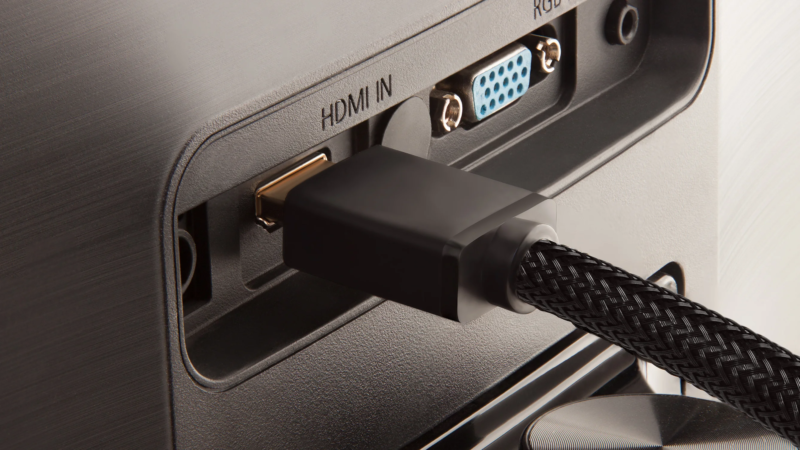
Introduction
If you’ve followed the display, graphics card or games console market at all recently you will surely have heard about HDMI 2.1. It’s the new connection interface standard widely being adopted on new graphics cards, displays, games consoles and other devices; allowing support for improved bandwidths, resolutions, refresh rates and features. It’s one of the hot topics at the moment when it comes to buying a new device, and promoted heavily by manufacturers, often as one of the leading items in their spec.
In this article we want to look at what the “HDMI 2.1” term really means, and address a worrying early sign in the market of things to come. We’ve delved in to what is required for this certification and what that means to you as a consumer if you ever want to buy something labelled with HDMI 2.1. Don’t make any assumptions about what that will give you, sadly it doesn’t seem to be nearly as simple as that.
What do you think of when you hear HDMI 2.1?
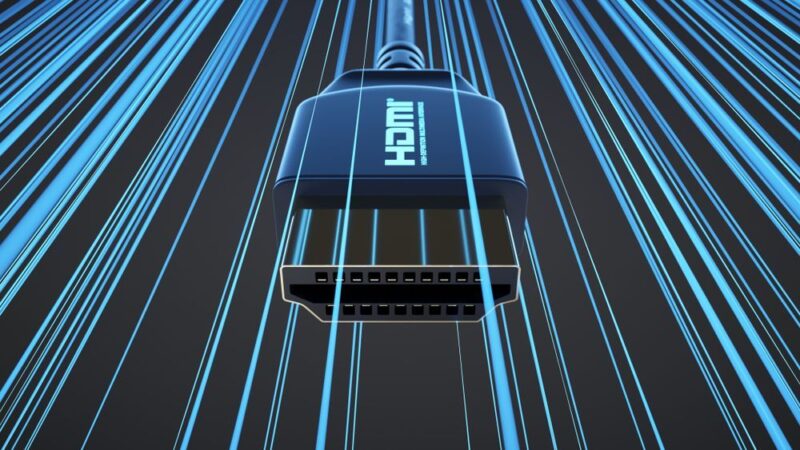
It’s probably useful to initially consider what most people think of when they hear the term HDMI 2.1. Technical aspects and specifications aside, in the display (monitors and TV) market the term has become associated in the minds of most with several key capabilities and features. This is largely driven by the games console market where HDMI 2.1 was adopted for the Sony PS5 and Microsoft Xbox Series X|S to power their latest capabilities. HDMI 2.1 also features in the PC graphics card space as an alternative to DisplayPort, but its really the games console market where the term has received mainstream attention and set expectations for most people.
The capabilities and features are things not previously possible with older HDMI standards like v2.0, or at least not in the more mainstream way they are supported now with v2.1. They include:
- Support for much higher bandwidths than older generations, allowing for…
- Support for higher resolutions – including 4K and even up to 8K
- Support for the combination of 4K and 120Hz high refresh rate (including at 10-bit, HDR and without colour compression)
- Variable Refresh Rate (VRR) support
- ALLM (Auto Low Latency Mode) support
So these are all things most people probably expect an HDMI 2.1 display to support, and we think it is fair to say these would be the benefits they expect to have available to them when buying a display with HDMI 2.1 advertised. Sadly, as you will read in a moment, it isn’t nearly as simple as that.
The New Supported Capabilities Explained
Bandwidth, Resolution and Refresh Rate
To reach the all-important 4K 120Hz support (including 10-bit colour uncompressed) you need a higher bandwidth than was possible with HDMI 2.0. We will ignore resolutions beyond 4K for now as they are not really available in the monitor market anyway, and the focus is very much on 4K right now. For more info on potential supported resolutions see HDMI.org here.
HDMI 2.1 as a standard can support “FRL” (Fixed Rate Link) signalling. As HDMI.org explain on their website: “FRL stands for Fixed Rate Link and it’s a signalling technology supported in the HDMI 2.1 Specification. FRL is necessary to achieve the higher uncompressed resolutions such as those above 4k60 as well as the ultra high speed bandwidths up to 48Gbps. It’s also required for compressed video transport which in turn enables operation at lower data rates for example 4k60 and ultra-high pixel rate video such as 10Kp120.“
FRL replaces the older TMDS (Transition Minimised Differential Signalling) signalling method that was used by the older HDMI 2.0 to deliver then the maximum 18Gbps transmission bandwidth on that interface. TMDS allowed support for 4K 60Hz 8-bit colour depth but is nowhere near sufficient to support 4K 120Hz 10-bit uncompressed colour. The newer FRL signalling boosts the port bandwidth to 48Gbps maximum. Support for Display Stream Compression (v1.2) was also added to the HDMI 2.1 standard allowing even higher resolutions thanks to the additional visually lossless compression.
As HDMI.org explain on their website, the HDMI 2.1 specification still requires support for TMDS for backwards compatibility to seamlessly support the billions of HDMI devices that utilize TMDS, but you need to keep in mind that to support the higher bandwidths necessary for things like 4K 120Hz, it needs to support FRL too.
So in summary – TMDS signalling will support capabilities from HDMI 2.0 generation devices, and the newer FRL will support the higher bandwidths, resolutions and refresh rates most people associate with HDMI 2.1.
Variable Refresh Rate (VRR)
More specifically “HDMI-VRR“, this is a technology that can be built in to HDMI 2.1 allowing for variable frame rates from compatible graphics cards and modern games consoles. VRR can be used to reduce tearing and stuttering in varying frame rate gaming, and has already been implemented by Microsoft on their Xbox Series X/S consoles. PS5 support is expected at some point but not currently available.
Auto Low Latency Mode (ALLM)
Auto Low Latency Mode is a feature that allows a display to detect a gaming input like a console and then automatically switch to a define mode which the display manufacturer has optimised for this usage. Normally this means automatically switching to a ‘game’ preset mode where input lag has been reduced and a lot of the normal ‘movie’ enhancement features are disabled. In the TV market if you were buying a display with HDMI 2.1 you would probably expect and want it to support ALLM to allow this. In the monitor space to be honest it’s less important as all modes generally have the same low lag anyway. So you could probably argue that ALLM is expected from an HDMI 2.1 TV, but not really for a monitor.
The following table is provided courtesy of HDMI Licensing Administrator, Inc. and shows the full list of new features associated with HDMI 2.1. There is detail about other things not discussed here like eARC (for audio) on their website if you want more.
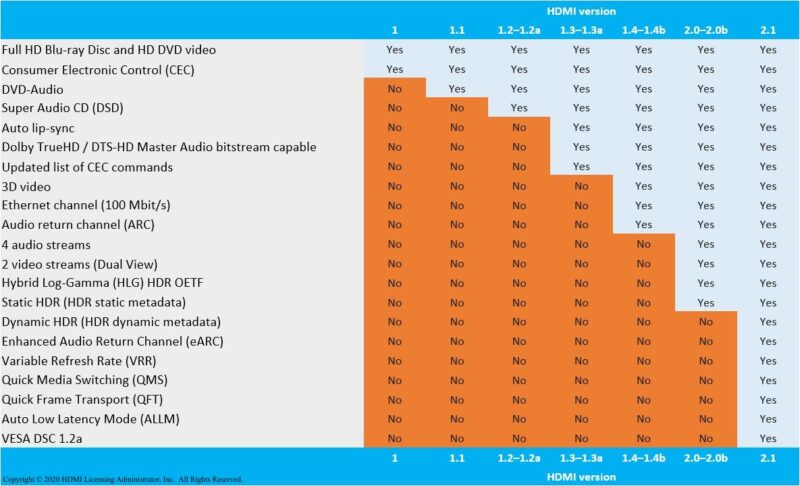
“Fake HDMI 2.1” and the Start of the Confusion
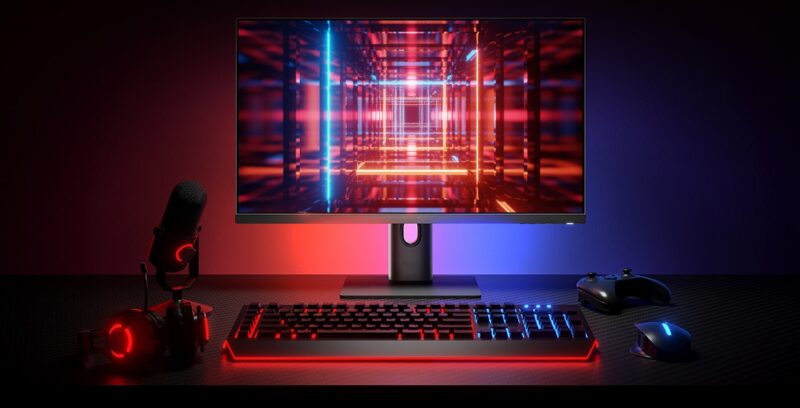
The display that prompted this investigation was from Chinese manufacturer mi.com, and was their so-called “Xiaomi Fast LCD Monitor 24.5-inch 240Hz version“. This is a 24.5” sized display with a 1080p resolution and 240Hz refresh rate. At the bottom of their product page they list inclusion of 2x HDMI 2.1 ports:

However, beneath that at the bottom of the page hidden in the terms and conditions they then say the following (translated): “Due to the subdivision of HDMI certification standards, HDMI 2.1 is divided into TMDS (the bandwidth is equivalent to the original HDMI 2.0 and FRL protocols). The HDMI 2.1 interface of this product supports the TMDS protocol, the maximum supported resolution is 1920×1080, and the maximum refresh rate is 240Hz.”
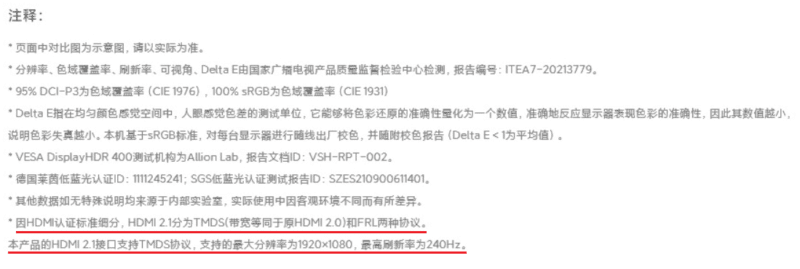
This rang alarm bells for us, as it appeared that they were advertising a device which had only the capabilities of HDMI 2.0 under the new HDMI 2.1 name. It even specifically says it only used TMDS from v2.0 and not FRL. We’ve already touched on what we think an average consumer will expect when they see HDMI 2.1 listed, and so we queried this with HDMI.org, the HDMI Licensing Administrator to see whether this was dodgy or “fake”.
What Does the HDMI 2.1 Certification Actually Require? Not a Lot it Seems…
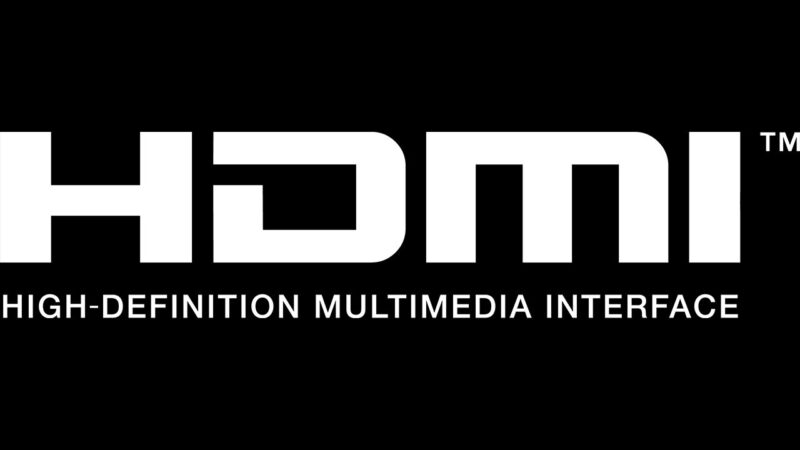
We covered above what we believe the common consumer expectation is in terms of capabilities and features when they see HDMI 2.1 advertised. If you delve in to the detail of HDMI 2.1 you will probably be surprised to hear that actually none of these things are required!
We contacted HDMI.org who are the “HDMI Licensing Administrator” to ask some questions about this new standard, seek clarification on several questions we had and discuss the Xiaomi display we mentioned above. Here is what we were told:
- HDMI 2.0 no longer exists, and devices should not claim compliance to v2.0 as it is not referenced any more
- The features of HDMI 2.0 are now a sub-set of 2.1
- All the new capabilities and features associated with HDMI 2.1 are optional (this includes FRL, the higher bandwidths, VRR, ALLM and everything else)
- If a device claims compliance to 2.1 then they need to also state which features the device supports so there is “no confusion” (hmmmm)
So according to what they have told us, this means that in theory all future devices with an HDMI 2.x connection should now be labelled as HDMI 2.1, even though at the end of the day they may only offer the capabilities of the older HDMI 2.0 generation. With HDMI 2.0 certification now discontinued, these are basically 2.0 devices hiding under the replacement banner name of 2.1. They don’t have to offer any new capabilities whatsoever, but they are still supposed to be labelled as 2.1 it seems.
In my personal opinion this is a very bad way to certify anything. What is wrong with certifying devices that only have 2.0 capabilities as 2.0? Why should that be closed and no longer referenced? Why not have a standard that says that if you want to label your device as 2.1, it must support x and y features? When a term carries particular connotations with the market, it should deliver those expectations. The certification should at least define a base-line.
The response from HDMI.org was that the intention is that while everything can – or rather should be labelled as HDMI 2.1, manufacturers also have to list the features supported to conform to their certification criteria. As far as I can tell, this means that the HDMI 2.1 name itself is pretty meaningless (for the record, HDMI.org didn’t agree with this statement and objected to me saying that). But if every capability and feature is optional, on it’s own when you see something labelled as “HDMI 2.1” it tells you nothing relative to the older days of HDMI 2.0. It is associated with certain things in the minds of the consumer, but actually it means nothing on its own. It is only when HDMI 2.1 is listed in conjunction with specific named features that it has any real relevance.
This means that actually what Xiaomi are advertising with their 24.5″ 1080p 240Hz monitor is correct, by the definition of the HDMI licencing administrator. It’s not “fake HDMI 2.1” after all. The ports have absolutely no new capabilities beyond 2.0, yet they are being advertised to consumers as 2.1 which in my opinion is misleading. Since it has none of the new capabilities there is nothing for them to list alongside that HDMI 2.1 name, so it’s just blank. Obviously you can tell that the screen will be a max 1080p and 240Hz (120Hz for consoles) so you wouldn’t be expecting 4K 120Hz here anyway, but the use of that name might well imply to an average consumer that it would feature things like HDMI-VRR or ALLM.
This would of course get even more confusing and misleading if a screen with a 4K resolution and 120Hz+ refresh rate did this. If it only had HDMI 2.0-type ports and bandwidth then that could still support 4K 120Hz, but it would have to be at 8-bit colour depth and with 4:2:0 chroma sub-sampling to fit within the older TMDS bandwidth. This is what we saw on the Asus ROG Swift PG32UQX, but at least Asus were up front and labelled it as HDMI 2.0 and called out the limitations. What if they hadn’t though? What if they’d just listed 4K 120Hz over HDMI and called it HDMI 2.1 (as HDMI org say you can)? You’d probably expect full colour support in that case. They’d be listing what is supported but aren’t calling out what isn’t supported as they don’t have to apparently. And what about features like VRR and ALLM? If the ports were labelled as HDMI 2.1 you’d probably expect these to be featured, but you would only know for sure if the manufacturer listed them specifically, and the absence of them in the spec would actually mean they aren’t supported.
This seems like a mess waiting to happen in my opinion. Great if manufacturers deliver the new HDMI 2.1 features, I’m sure they will definitely want to promote those. But what about all those devices where nothing new is supported and they are simply “HDMI 2.1” now? Is your average consumer going to realise that the absence of listed features means they are not supported, or are they going to assume that because it’s HDMI 2.1 it will work fully with their other HDMI 2.1 device (like a games console) that lists certain things?
A Request to Display Manufacturers
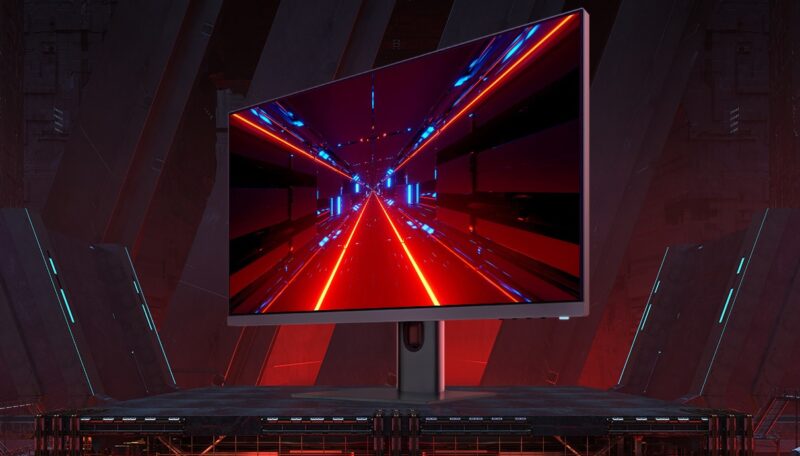
Interestingly what we have seen so far in the market seems to be contrary to the guidelines HDMI.org detailed to us. HDMI 2.0 capable displays are still being labelled and marketed as HDMI 2.0 and actually we think this is a good thing. In nearly all cases everything marketed as HDMI 2.1 at least includes the high bandwidth support beyond HDMI 2.0, with most delivering the additional features like VRR too. We would much rather see the continued use of HDMI 2.0 labelling than a mass “abuse” of the HDMI 2.1 name. Ideally this would continue, but the HDMI.org guidance seems to be contrary to this.
In our opinion, an absolute base-line requirement for a display to be listed as 2.1 should be support for FRL to allow new bandwidths beyond 2.0. The most important upgrade in this new 2.1 standard is that boost above 18Gbps bandwidth, and the support for higher resolution and refresh rates. All the HDMI 2.1 advertised displays we have seen so far, with the exception of the Xiaomi model discussed above, offer at least this improvement. If a display (like the Xiaomi) can only do the old TMDS signalling HDMI 2.0 bandwidth then it would be far cleaner to label that as HDMI 2.0. We’d really love it if features like VRR, ALLM etc were compulsory under the 2.1 certification as well, as it would make it so much cleaner for the consumer.
However, if there is to be a shift towards every HDMI 2.x device being lumped under the banner of 2.1, we would ask display manufacturers to be super clear on their product pages and specs about which features are supported, and just as important are not supported. According to the licensor rules, they should be listing the supported features anyway (FRL, VRR, ALLM etc) but we think that just important to avoid confusion is to list those features not supported. If you want to be honest and transparent with the market then this would go a long way. Please don’t hide everything under the HDMI 2.1 name and fail to deliver the features that a consumer expects to see, just because technically you can. Tell us what bandwidth is supported, what resolution, refresh rate, colour levels and advanced features are and are not included over the HDMI connection so no one is mislead.
How is a Consumer Supposed to Know?
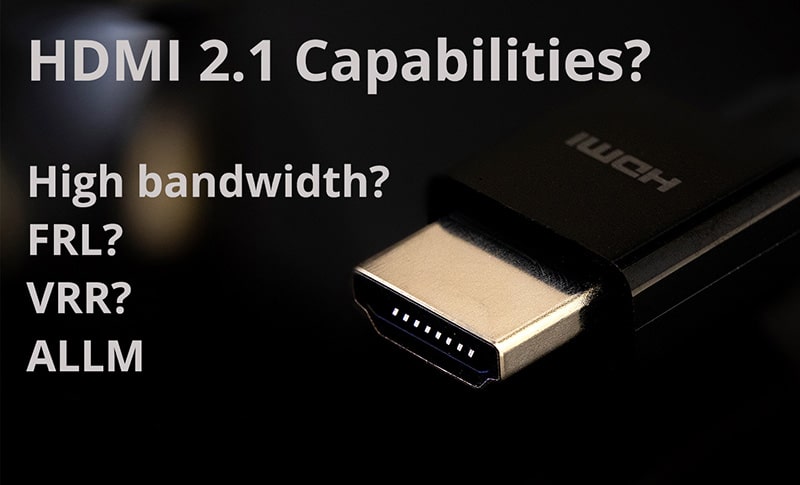
Based on the HDMI.org guidelines it seems inevitable that we will see at least from smaller manufacturers more displays marketed with supposed HDMI 2.1 connections in the future, and perhaps, disappointingly, the removal of the HDMI 2.0 name altogether. If this happens then our guidance would probably have to be that you should generally ignore the HDMI 2.1 branding. You can’t make any assumptions whatsoever about the performance or capabilities of a display simply based on that term. instead you can only really rely on the specifically listed features. Hopefully manufacturers will be transparent about this, but if something is not listed in the specs directly, then you can only assume that it is not available.
I suppose that can maybe work, but to be honest I think it’s a bit of a shame that the standard was not clearer. It would be much better, in my personal opinion, if HDMI 2.1 had a defined set of requirements and only where they are all supported should that term then be used. If you want to have a few tiers of features to give flexibility then fine, just have HDMI 2.0, 2.1, 2.2, 2.3 or whatever. Or make the jump from v2.0 to v3.0 and have a defined list. At the moment although you might associate certain things with the term HDMI 2.1, you shouldn’t.
From our point of view with our content we already test and confirm which features and capabilities a screen offers where it is advertised with HDMI 2.1 and we will provide improved focus on this in the future in all our news, reviews etc. Like we are intending to be, hopefully all media outlets will be mindful of this term and be extra sceptical about what it is really offering.
Additional Reading: Guide: How to Buy an HDMI 2.1 Display and a Real HDMI 2.1 Cable
Update: HDMI 2.1a – Further Future Confusion
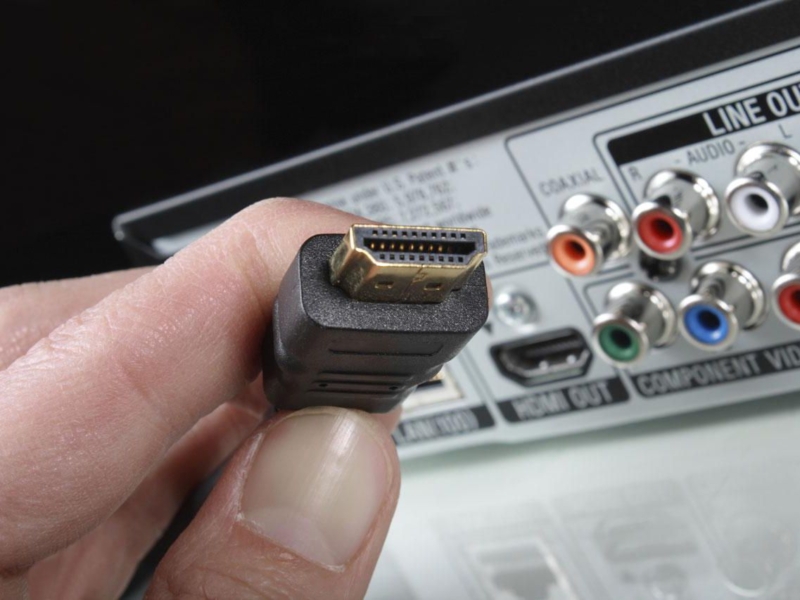
On 23 Dec 2021 we published an additional article about the update to the HDMI certification scheme which will now be updated to v2.1a. This is just the latest update to the certification scheme and all future HDMI certified devices will technically be certified under this new and most recent scheme. HDMI 2.1 will be closed, and 2.1a will be the active certification scheme. With the announcement of the 2.1a update, HDMI LA also announced a new HDR ‘Source-Based Tone Mapping’ capability designed to optimise HDR experience and performance. However, like all the other features associated in the minds of the consumer with the branding of “HDMI 2.1”, whether that’s high FRL bandwidth, VRR, ALLM, eARC or anything else – this new SBTM feature is also optional.
This means that officially all future HDMI certified devices would be certified under the 2.1a scheme, although manufacturers are not supposed to label the version number in their spec pages or marketing at all, they are only supposed to list “HDMI” and then provide a breakdown of which optional features are supported. As we’ve discussed above, this makes it super confusing when buying a new device or display, as manufacturers could (and probably will) label their devices as “HDMI 2.1”, or probably now “HDMI 2.1a”.
This forthcoming update to 2.1a will further add to this confusion we think, as a new iteration implies to most people a change or an improvement in capabilities. When they then hear about how this new SBTM feature was added, they might assume that a 2.1a device would therefore include it. That would probably seem logical, but in actual fact the capability is optional and isn’t necessarily included.
We wrote an article recently about How to Buy an HDMI 2.1 Display and a Real HDMI 2.1 Cable in which we discussed the need to ignore the version number listed by a manufacturer if they provide it (which they officially shouldn’t), and instead look specifically for the listed supported features that you might want. This new SBTM feature is in the same boat, if you want it, then you’ll need to look for it being specifically listed in the specs. Do not assume that something labelled as 2.1a supports SBTM, at some point we expect most new HDMI certified devices to be labelled as 2.1a regardless of which of the optional features they support.
We may earn a commission if you purchase from our affiliate links in this article- TFTCentral is a participant in the Amazon Services LLC Associates Programme, an affiliate advertising programme designed to provide a means for sites to earn advertising fees by advertising and linking to Amazon.com, Amazon.co.uk, Amazon.de, Amazon.ca and other Amazon stores worldwide. We also participate in a similar scheme for Overclockers.co.uk, Newegg, Bestbuy , B&H and some manufacturers.
Stay Up To Date
 |  |  |  |
| Browser Alerts | Follow on X | Subscribe on YouTube | Support Us |
Popular Trending Articles
 4th Gen Primary RGB Tandem OLED Monitors Are Here! – Gigabyte MO27Q28G Showcase August 22, 2025 Explaining 4th Gen Primary RGB Tandem WOLED and it’s benefits and specs. Including a showcase of the Gigabyte MO27Q28G monitor
4th Gen Primary RGB Tandem OLED Monitors Are Here! – Gigabyte MO27Q28G Showcase August 22, 2025 Explaining 4th Gen Primary RGB Tandem WOLED and it’s benefits and specs. Including a showcase of the Gigabyte MO27Q28G monitor The Best Black Friday Monitor Deals – 2025 Tracker November 26, 2025 Loads of great deals to be had on monitors for the Black Friday sales period across a range of retailers and brands. Check the best recommendations here
The Best Black Friday Monitor Deals – 2025 Tracker November 26, 2025 Loads of great deals to be had on monitors for the Black Friday sales period across a range of retailers and brands. Check the best recommendations here Here’s Why You Should Only Enable HDR Mode on Your PC When You Are Viewing HDR Content May 31, 2023 Looking at a common area of confusion and the problems with SDR, desktop and normal content when running in HDR mode all the time
Here’s Why You Should Only Enable HDR Mode on Your PC When You Are Viewing HDR Content May 31, 2023 Looking at a common area of confusion and the problems with SDR, desktop and normal content when running in HDR mode all the time Gen 4 Samsung QD-OLED 2025 Panels and Improvements April 14, 2025 A complete look at Samsung Display’s latest QD-OLED updates and news for 2025 including new technologies, improvements and specs
Gen 4 Samsung QD-OLED 2025 Panels and Improvements April 14, 2025 A complete look at Samsung Display’s latest QD-OLED updates and news for 2025 including new technologies, improvements and specs QD-OLED Generations Infographic and FAQ June 17, 2025 A handy infographic explaining all QD-OLED panel generations along with answers to frequently asked questions
QD-OLED Generations Infographic and FAQ June 17, 2025 A handy infographic explaining all QD-OLED panel generations along with answers to frequently asked questions
